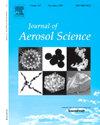双组分系统中不同碰撞状态下的碰撞频率
IF 3.9
3区 环境科学与生态学
Q2 ENGINEERING, CHEMICAL
引用次数: 0
摘要
聚结是粒子系统中最重要的生长过程,但建模工作通常假定单分散的初级粒子分布来封闭决定生长率的碰撞频率。然而,实际系统(如发烟火焰)涉及多分散初级粒子分布。此外,具有多种成分的系统,其原始粒子大小不同,也不能作为单分散系统处理。在此,我们引入了双分散初级粒子分布,并使用朗格文动力学模拟来开发适用于各种团聚特征的碰撞内核闭包。模拟涵盖的分形尺寸从 1.4 到 2.2,初级粒子直径从 5 纳米到 50 纳米,初级粒子尺寸比从 2 到 10,以及不同粒子组成的 200 个初级粒子大小的团聚体。朗格文动力学模拟涵盖了从弹道碰撞到扩散碰撞的所有碰撞机制,并推导出了各自碰撞直径、流体力学半径和投影面积的表达式,这些表达式是颗粒特性的函数。结果表明,在对碰撞直径和阻力系数进行精确建模的条件下,为球形粒子碰撞核建模而开发的现有过渡机制表达式仍然适用于双组分系统中的团聚体碰撞核。针对粒径比为 6 的 "后验 "模拟示例使用了种群平衡方程,并证明需要使用双变量核来准确预测增长率。模拟结束时预测的数量密度误差小于 12%,而为单分散原生颗粒系统开发的单变量内核对增长率的预测高出 46%。本文章由计算机程序翻译,如有差异,请以英文原文为准。
Collision frequencies across collision regimes in two-component systems
Agglomeration is the most important growth process in particle systems but modelling efforts typically assume mono-disperse primary particle distributions for the closure of the collision frequency that determines the growth rates. Real systems such as sooting flames, however, involve poly-disperse primary particle distributions. Also, systems with multiple components, where primary particles are of distinct but different sizes, cannot be treated as mono-disperse. Here, we introduce bi-disperse primary particle distributions and use Langevin dynamics simulations to develop closures for the collision kernels that are applicable over a wide range of agglomerate characteristics. The simulations cover fractal dimensions from 1.4 to 2.2, primary particle diameters from 5 nm to 50 nm, primary particle size ratios from 2 to 10 and agglomerates of up to a size of 200 primary particles with varying particle compositions. The Langevin dynamics simulations cover all collision regimes from ballistic to diffusive and allow to deduce expressions for the respective collision diameters, the hydrodynamic radii and the projected area as functions of particle characteristics. It is shown that existing expressions for the transition regime that were developed for the modelling of the collision kernel of spherical particles continue to hold for collision kernels of agglomerates in two-component systems under the condition that the collision diameters and drag coefficients are modelled accurately. An example ‘a posteriori’ simulation for a particle size ratio of 6 uses the population balance equation and demonstrates that bi-variate kernels are needed for the accurate prediction of the growth rates. Errors in predicted number density at the end of the simulations are less than 12 % while mono-variate kernels developed for mono-disperse primary particle systems overpredict the growth rate by 46%.
求助全文
通过发布文献求助,成功后即可免费获取论文全文。
去求助
来源期刊

Journal of Aerosol Science
环境科学-工程:化工
CiteScore
8.80
自引率
8.90%
发文量
127
审稿时长
35 days
期刊介绍:
Founded in 1970, the Journal of Aerosol Science considers itself the prime vehicle for the publication of original work as well as reviews related to fundamental and applied aerosol research, as well as aerosol instrumentation. Its content is directed at scientists working in engineering disciplines, as well as physics, chemistry, and environmental sciences.
The editors welcome submissions of papers describing recent experimental, numerical, and theoretical research related to the following topics:
1. Fundamental Aerosol Science.
2. Applied Aerosol Science.
3. Instrumentation & Measurement Methods.
 求助内容:
求助内容: 应助结果提醒方式:
应助结果提醒方式:


